Performance Analysis of PCM Ceiling Coupling with Earth-Air Heat Exchanger for Building Cooling
Abstract
:1. Introduction
2. Materials and Methods
2.1. Experimental Area and Climate
2.2. System Description
2.3. Preparation of the PCM
2.4. Operation Strategy
2.5. Measuring Tools
3. Results and Discussion
3.1. Operation Effects of EAHE System under Two Strategies
3.2. Thermal Performance of Room 1 and Room 2 under Two Strategies
3.3. Vertical Contrast of Ceiling Temperature
3.4. Horizontal Contrast of Ceiling Temperature
3.5. Comparison of Heat Flux on Different Ceiling Surfaces
3.6. Analysis of Phase Transition Duration
4. Conclusions
- Experimental results showed that the 4.87% DE-95.13% CA mixture was suitable for building cooling. However, this combination had the problem that the latent heat of solidification was higher than the one for melting, which was not conducive to the cooling effect of PCM. In this case, it is necessary to further optimize the thermal performance of the composite PCM or find alternatives.
- For the EAHE system section, excessive continuous running time was not conducive to the sustainability of the earth-to-air heat exchanger.
- Compared with the room without the newly proposed system, the indoor peak temperature reduced by 2.1 °C under 8-h timed cold storage strategy and 2.7 °C under 12-h timed cold storage strategy with the help of the new system, meaning that the system reduced the indoor peak temperature effectively. Thus, the indoor air conditioning system could undertake less cooling load during daytime.
- Comparison of multiple sets of data showed that temperature and heat flux of the PCM ceiling had similar distribution characteristics regardless of strategy. Different strategies mainly affected the phase transition efficiency of PCM ceiling. To make fuller use of PCM’s latent heat, enough cold storage time was necessary in practical application.
- Experimental data proved that ceiling flats with different orientations need different phase transition times while PCM in the bottom layer of the lower ceiling hardly worked. In this case, optimizing the heat exchange effect of the ceiling could start with the air flow organization optimization and the structural adjustment of the ceiling.
Author Contributions
Funding
Conflicts of Interest
References
- Amanowicz, L. Influence of geometrical parameters on the flow characteristics of multi-pipe earth-to-air heat exchangers -experimental and CFD investigations. Appl. Energy 2018, 226, 849–861. [Google Scholar] [CrossRef]
- Mousa, S.M.; Bilal, A.A. Some prospects of energy savings in buildings. Energy Convers. Manag. 2001, 42, 1307–1315. [Google Scholar]
- Serrano, A.; Dauvergne, J.L. Neopentyl Glycol as Active Supporting Media in Shape-Stabilized PCMs. Materials 2019, 12, 3169. [Google Scholar] [CrossRef] [Green Version]
- Doppiu, S.; Dauvergne, J.L. The Li2SO4-Na2SO4 System for Thermal Energy Storage. Materials 2019, 12, 3658. [Google Scholar] [CrossRef] [PubMed] [Green Version]
- Santos-Moreno, S.; Doppiu, S. Study of the Phase Transitions in the Binary System NPG-TRIS for Thermal Energy Storage Applications. Materials 2020, 13, 1162. [Google Scholar] [CrossRef] [Green Version]
- Pomianowski, M.; Heiselberg, P. A new experimental method to determine specific heat capacity of inhomogeneous concrete material with incorporated microencapsulated-PCM. Cem. Concr. Res. 2014, 55, 22–34. [Google Scholar] [CrossRef]
- Kang, Y.B.; Jiang, Y.; Zhang, Y.P. Modeling and experimental study on an innovative passive cooling system—NVP system. Energy Build. 2003, 35, 417–425. [Google Scholar]
- Kuznik, F.; Virgone, J. Experimental investigation of wallboard containing phase change material: Data for validation of numerical modeling. Energy Build. 2009, 41, 561–570. [Google Scholar] [CrossRef]
- Lazaro, A.; Dolado, P. PCM-air heat exchangers for free-cooling applications in buildings: Experimental results of two real-scale prototypes. Energy Convers. Manag. 2009, 42, 439–443. [Google Scholar] [CrossRef]
- Mehling, H.; Cabeza, L.F. Application of PCM for heating and cooling in buildings. Therm. Energy Storage Sustain. Energy Consum. 2007, 234, 323–348. [Google Scholar]
- Cabeza, L.F.; Castell, A. Materials used as PCM in thermal energy storage in buildings: A review. Renew. Sustain. Energy Rev. 2011, 15, 1675–1695. [Google Scholar] [CrossRef]
- Luo, C.L.; Xu, L.J. Experimental study of a modified solar phase change material storage wall system. Energy 2017, 128, 224–231. [Google Scholar] [CrossRef] [Green Version]
- Guarino, F.; Athienitis, A. PCM thermal storage design in buildings: Experimental studies and applications to solaria in cold climates. Appl. Energy 2017, 185, 95–106. [Google Scholar] [CrossRef]
- Zhou, D.; Zhao, C.Y.; Tian, Y. Review on thermal energy storage with phase change materials (PCMs) in building applications. Appl. Energy 2012, 92, 593–605. [Google Scholar] [CrossRef] [Green Version]
- Soares, N.; Costa, J.J. Review of passive PCM latent heat thermal energy storage systems towards buildings’ energy efficiency. Energy Build. 2013, 59, 82–103. [Google Scholar] [CrossRef]
- Chwieduk, D.A. Dynamics of external wall structures with a PCM (phase change materials) in high latitude countries. Energy 2013, 59, 301–313. [Google Scholar] [CrossRef]
- Dabiri, S.; Mehrpooya, M.; Nezhad, E.G. Latent and sensible heat analysis of PCM incorporated in a brick for cold and hot climatic conditions, utilizing computational fluid dynamics. Energy 2018, 159, 160–171. [Google Scholar] [CrossRef]
- Zhu, N.; Ma, Z.J.; Wang, S.W. Dynamic characteristics and energy performance of buildings using phase change materials: A review. Energy Convers. Manag. 2009, 50, 3169–3181. [Google Scholar] [CrossRef]
- Kuznik, F.; Virgone, J.; Johannes, K. Development and validation of a new TRNSYS type for the simulation of external building walls containing PCM. Energy Build. 2010, 42, 1004–1009. [Google Scholar] [CrossRef] [Green Version]
- Hu, Y.; Heiselberg, P.K. Experimental and numerical study of a PCM solar air heat exchanger and its ventilation preheating effectiveness. Renew. Energy 2020, 145, 106–115. [Google Scholar] [CrossRef]
- Li, D.; Wu, Y. Energy investigation of glazed windows containing Nano-PCM in different seasons. Energy Convers. Manag. 2018, 172, 119–128. [Google Scholar] [CrossRef]
- Li, D.; Zhang, C.J. Thermal performance evaluation of glass window combining silica aerogels and phase change materials for cold climate of China. Appl. Therm. Eng. 2020, 165, 114547. [Google Scholar] [CrossRef]
- Lu, S.; Xu, B.; Tang, X. Experimental study on double pipe PCM floor heating system under different operation strategies. Renew. Energy 2020, 145, 1280–1291. [Google Scholar] [CrossRef]
- Zhou, G.; He, J. Thermal performance of a radiant floor heating system with different heat storage materials and heating pipes. Appl. Energy 2015, 138, 648–660. [Google Scholar] [CrossRef]
- Fu, W.W.; Zou, T. Preparation and properties of phase change temperature-tuned composite phase change material based on sodium acetate trihydrate-urea/fumed silica for radiant floor heating system. Appl. Therm. Eng. 2019, 162, 114253. [Google Scholar] [CrossRef]
- Kondo, T.; Ibamoto, T. Research on thermal storage using rock wool phase-change material ceiling board. Ashrae Trans. 2006, 112, 526–531. [Google Scholar]
- Wang, X.C.; Niu, J.L. Performance of cooled-ceiling operating with MPCM slurry. Energy Convers. Manag. 2009, 50, 583–591. [Google Scholar] [CrossRef]
- Boccardo, L.B.; Kazanci, O.B. Economic comparison of TABS, PCM ceiling panels and all-air systems for cooling offices. Energy Build. 2019, 205, 109527. [Google Scholar] [CrossRef]
- Tzivanidis, C.; Antonopoulos, K.A.; Kravvaritis, E.D. Parametric analysis of space cooling systems based on night ceiling cooling with PCM-embedded piping. Int. J. Energy Res. 2012, 36, 18–35. [Google Scholar] [CrossRef]
- Lapka, P.; Jaworski, M. Efficiency optimisation of the thermal energy storage unit in the form of the ceiling panel for summer conditions. Int. J. Energy Res. 2019, 43, 2151–2161. [Google Scholar] [CrossRef]
- Alizadeh, M.; Sadrameli, S.M. Indoor thermal comfort assessment using PCM based storage system integrated with ceiling fan ventilation: Experimental design and response surface approach. Energy Build. 2019, 188, 297–313. [Google Scholar] [CrossRef]
- Barzin, R.; Chen, J.J.J. Application of PCM energy storage in combination with night ventilation for space cooling. Appl. Energy 2015, 158, 412–421. [Google Scholar] [CrossRef]
- Lin, W.Y.; Ma, Z.J. Development and evaluation of a ceiling ventilation system enhanced by solar photovoltaic thermal collectors and phase change materials. Energy Convers. Manag. 2014, 88, 218–230. [Google Scholar] [CrossRef]
- Yang, D.; Guo, Y.H.; Zhang, J.P. Evaluation of the thermal performance of an earth-to-air heat exchanger (EAHE) in a harmonic thermal environment. Energy Convers. Manag. 2016, 109, 184–194. [Google Scholar] [CrossRef]
- Serageldin, A.A.; Abdelrahman, A.K.; Ookawara, S. Earth-Air Heat Exchanger thermal performance in Egyptian conditions: Experimental results, mathematical model, and Computational Fluid Dynamics simulation. Energy Convers. Manag. 2016, 122, 25–38. [Google Scholar] [CrossRef]
- Barakat, S.; Ramzy, A. Enhancement of gas turbine power output using earth to air heat exchanger (EAHE) cooling system. Energy Convers. Manag. 2016, 111, 137–146. [Google Scholar] [CrossRef]
- Benhammou, M.; Draoui, B. Performance analysis of an earth-to-air heat exchanger assisted by a wind tower for passive cooling of buildings in arid and hot climate. Energy Convers. Manag. 2015, 91, 1–11. [Google Scholar] [CrossRef]
- Zhou, T.C.; Xiao, Y.M. Research on cooling performance of phase change material-filled earth-air heat exchanger. Energy Convers. Manag. 2018, 177, 210–223. [Google Scholar] [CrossRef]
- Zhou, T.C.; Xiao, Y.M. Numerical study on the cooling performance of a novel passive system: Cylindrical phase change material-assisted earth-air heat exchanger. J. Clean. Prod. 2020, 245, 14. [Google Scholar] [CrossRef]
- Liu, Z.X.; Sun, P.C. Enhancing a vertical earth-to-air heat exchanger system using tubular phase change material. J. Clean. Prod. 2019, 237, 12. [Google Scholar] [CrossRef]
- Liu, Z.X.; Yu, Z. Experimental and numerical study of a vertical earth-to-air heat exchanger system integrated with annular phase change material. Energy Convers. Manag. 2019, 186, 433–449. [Google Scholar] [CrossRef]
- Kong, X.F. Study on the Envelope Structure Performance of Phase Change Cold Storage Building. Ph.D. Thesis, Tianjin University, Tianjin, China, May 2013. [Google Scholar]
- Artmann, N.; Manz, H.; Heiselberg, P. Climatic potential for passive cooling of buildings by night-time ventilation in Europe. Appl. Energy 2007, 84, 187–201. [Google Scholar] [CrossRef]
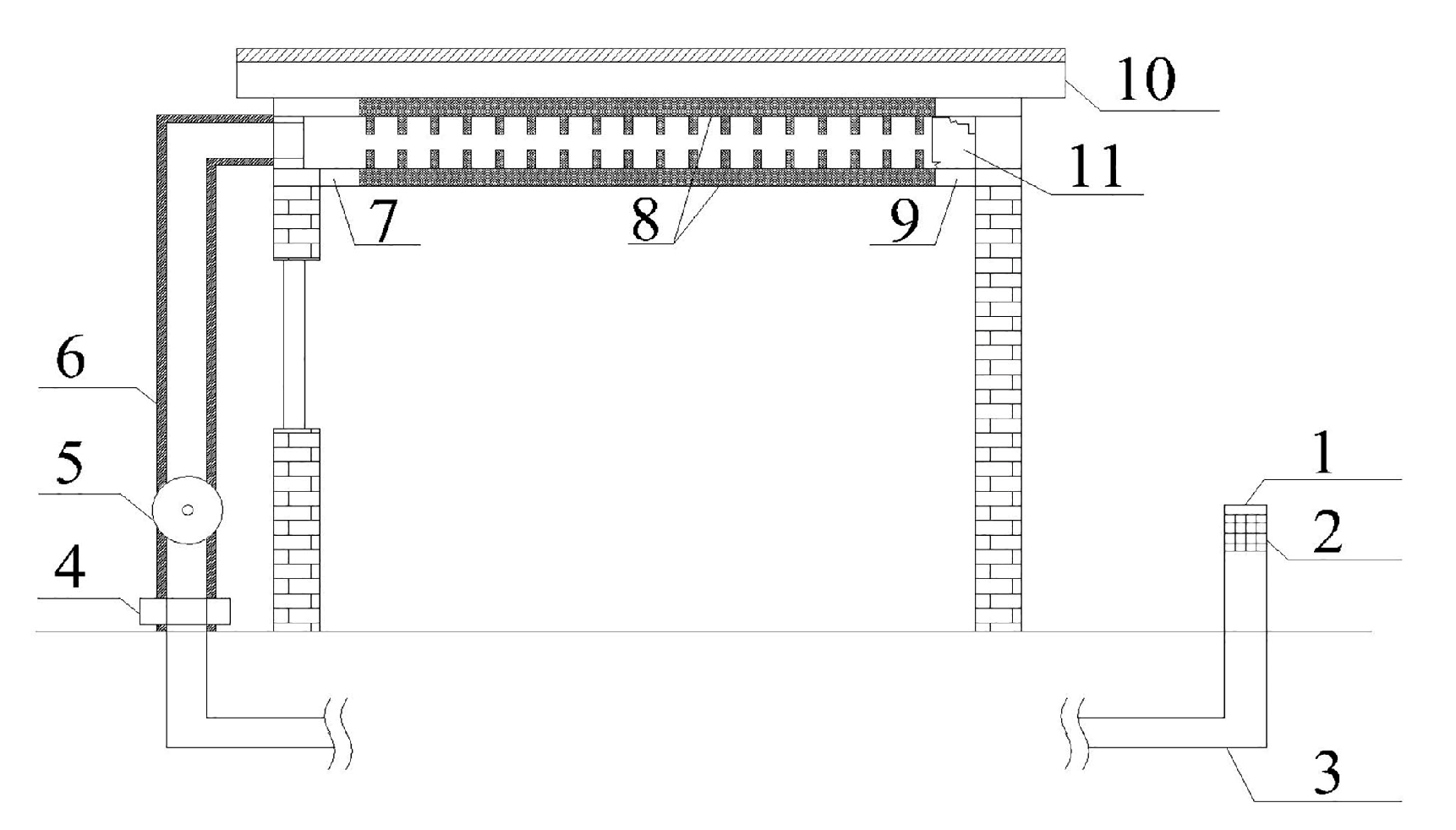
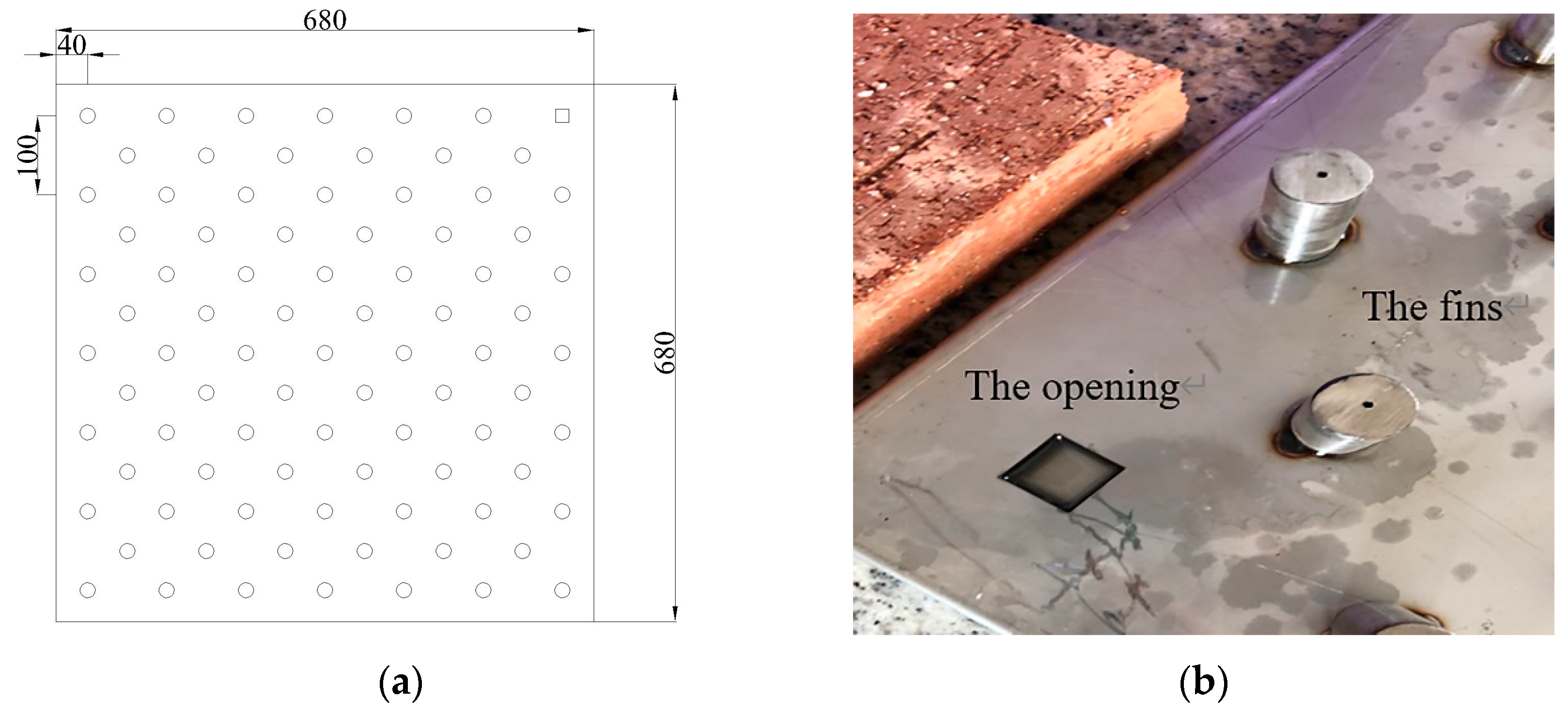
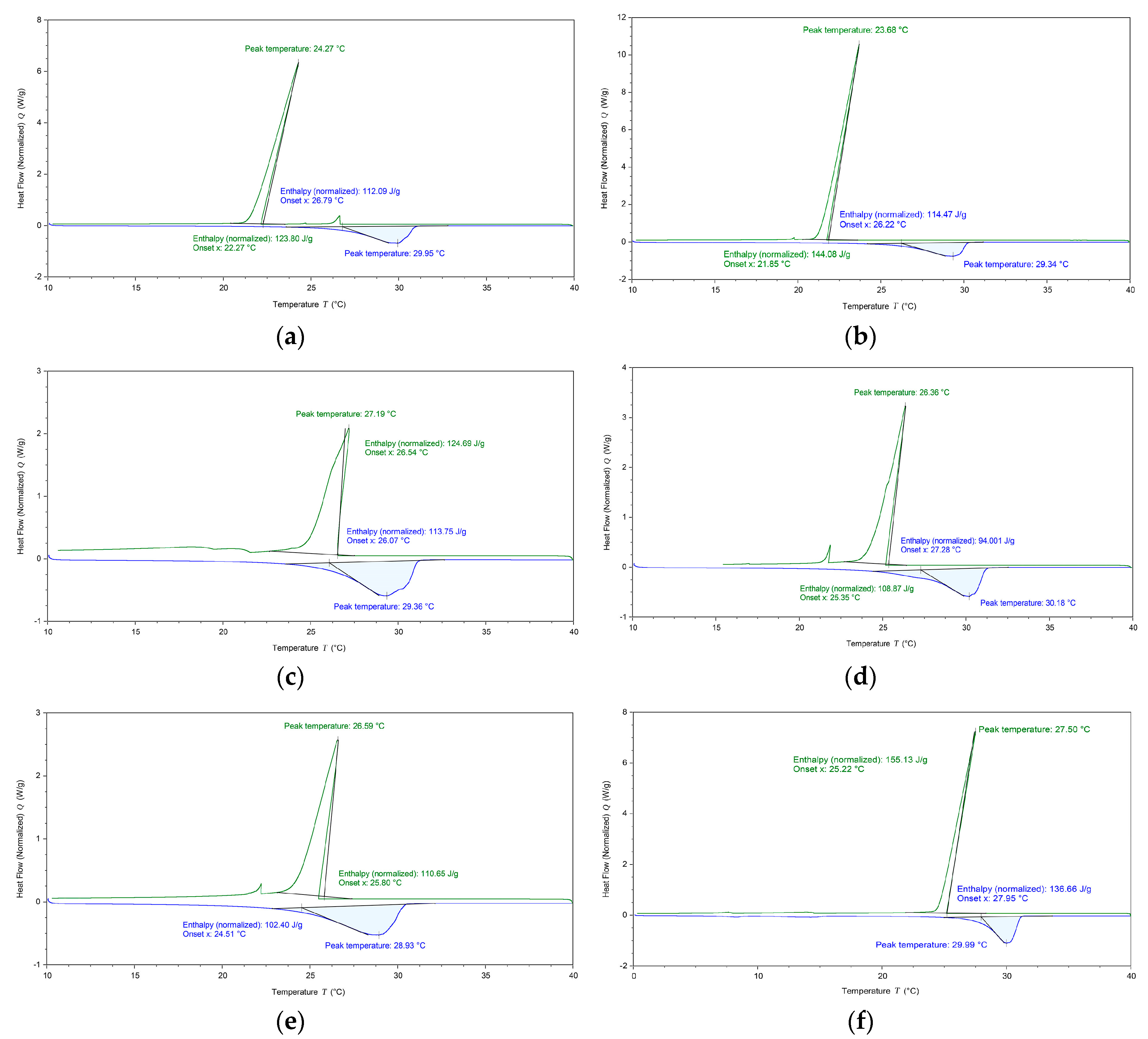
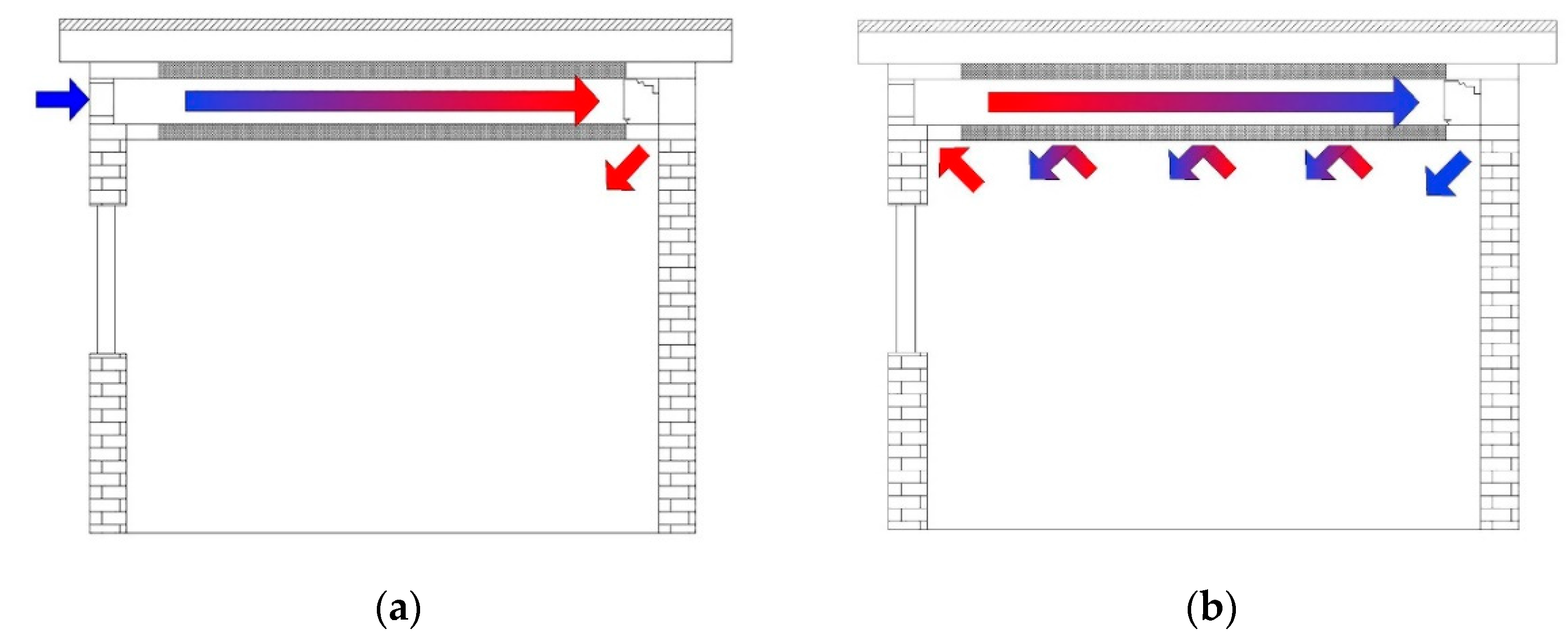
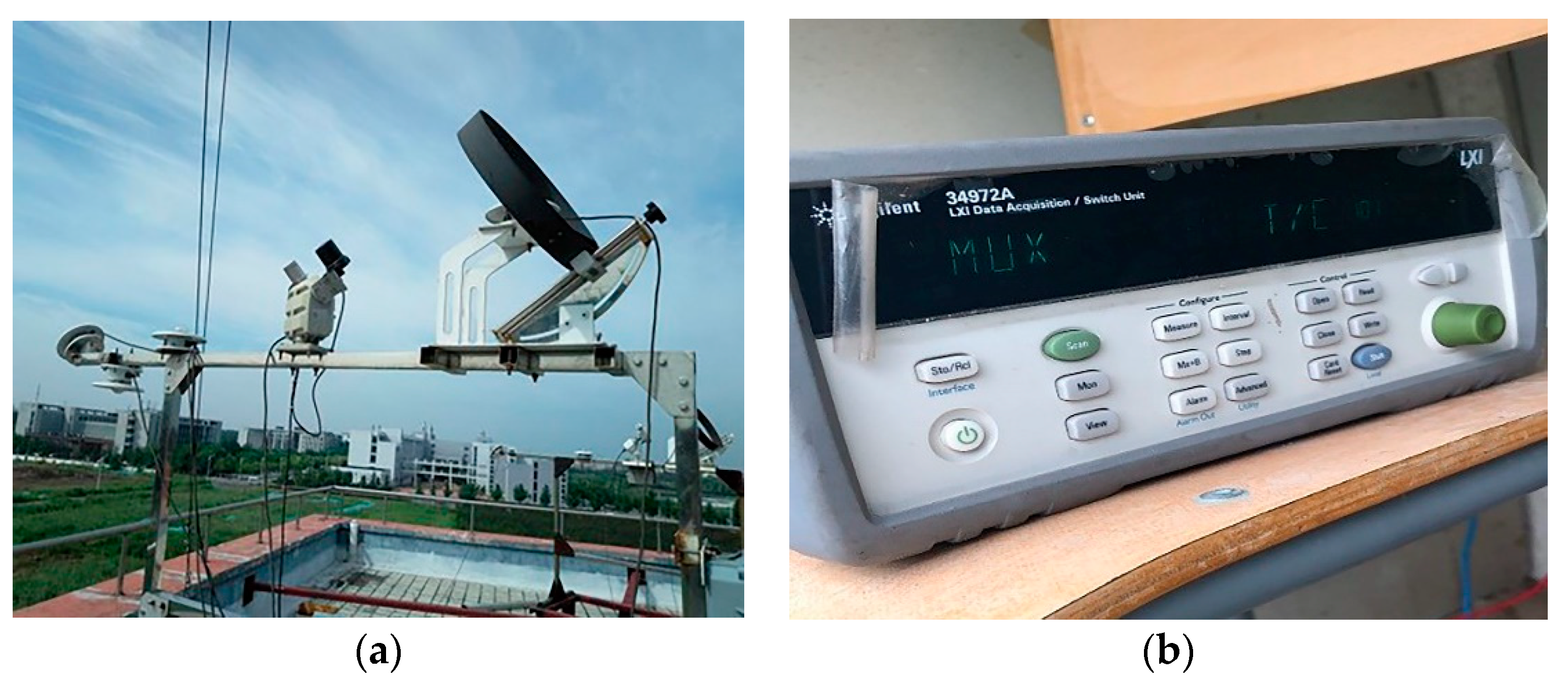
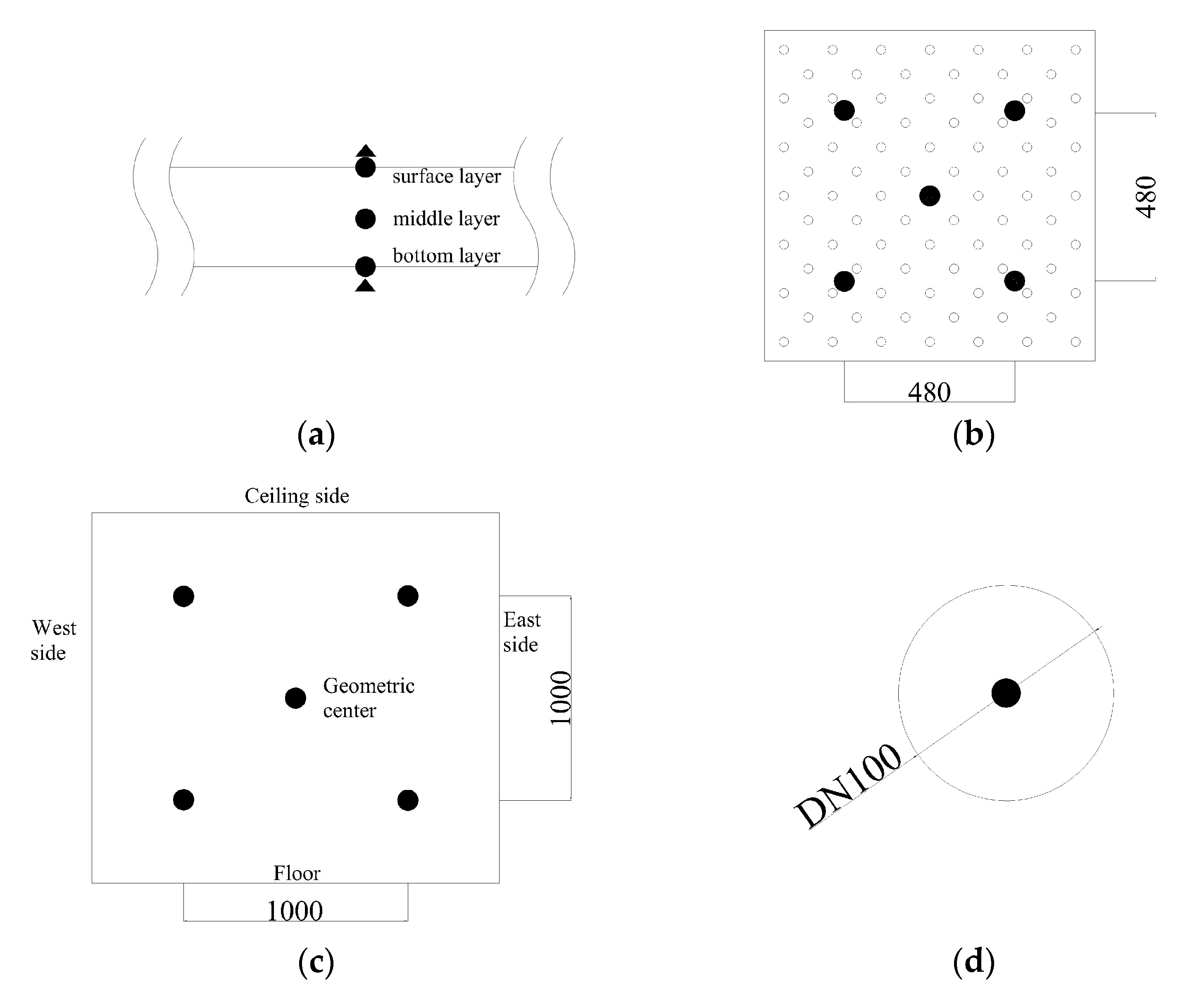

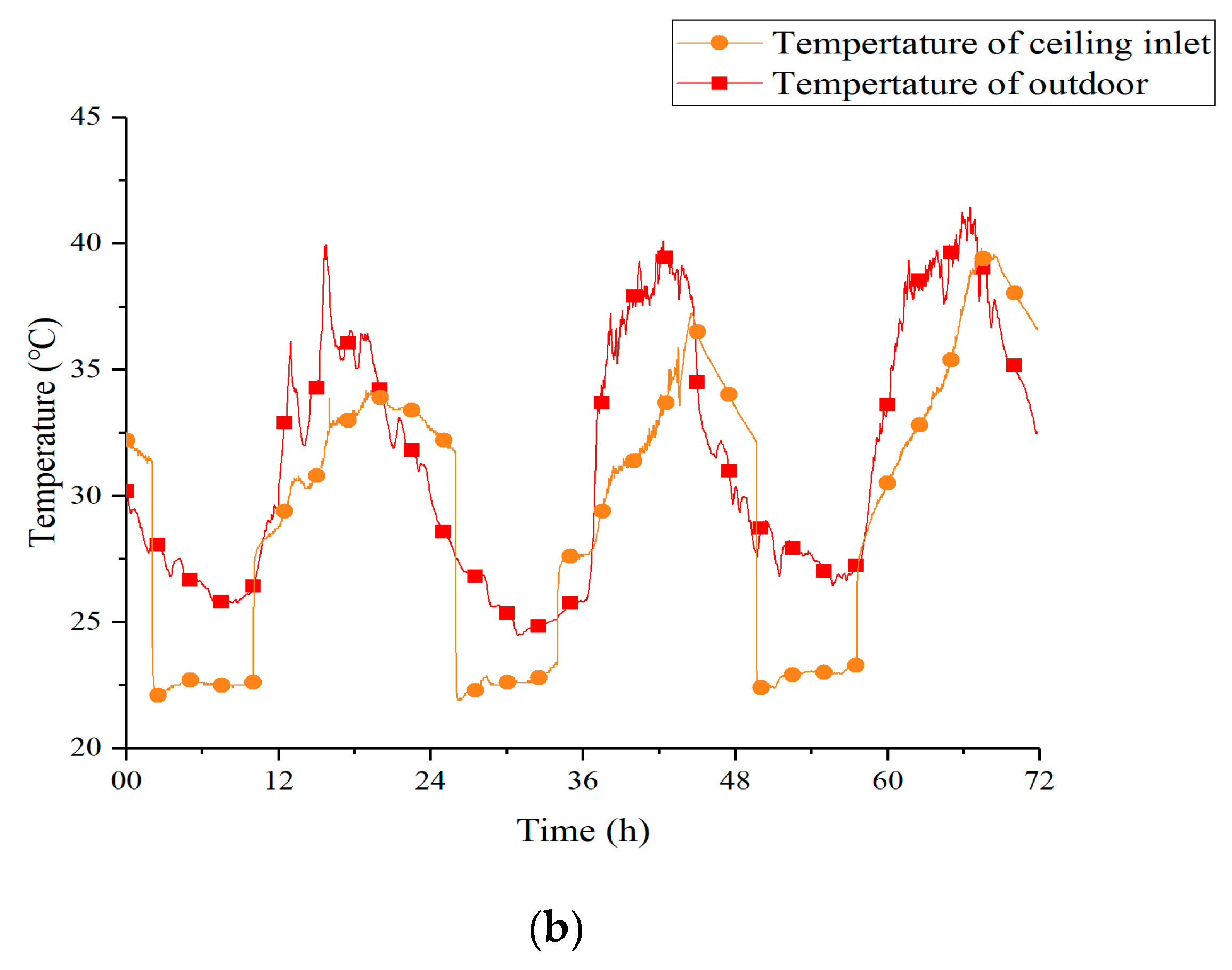
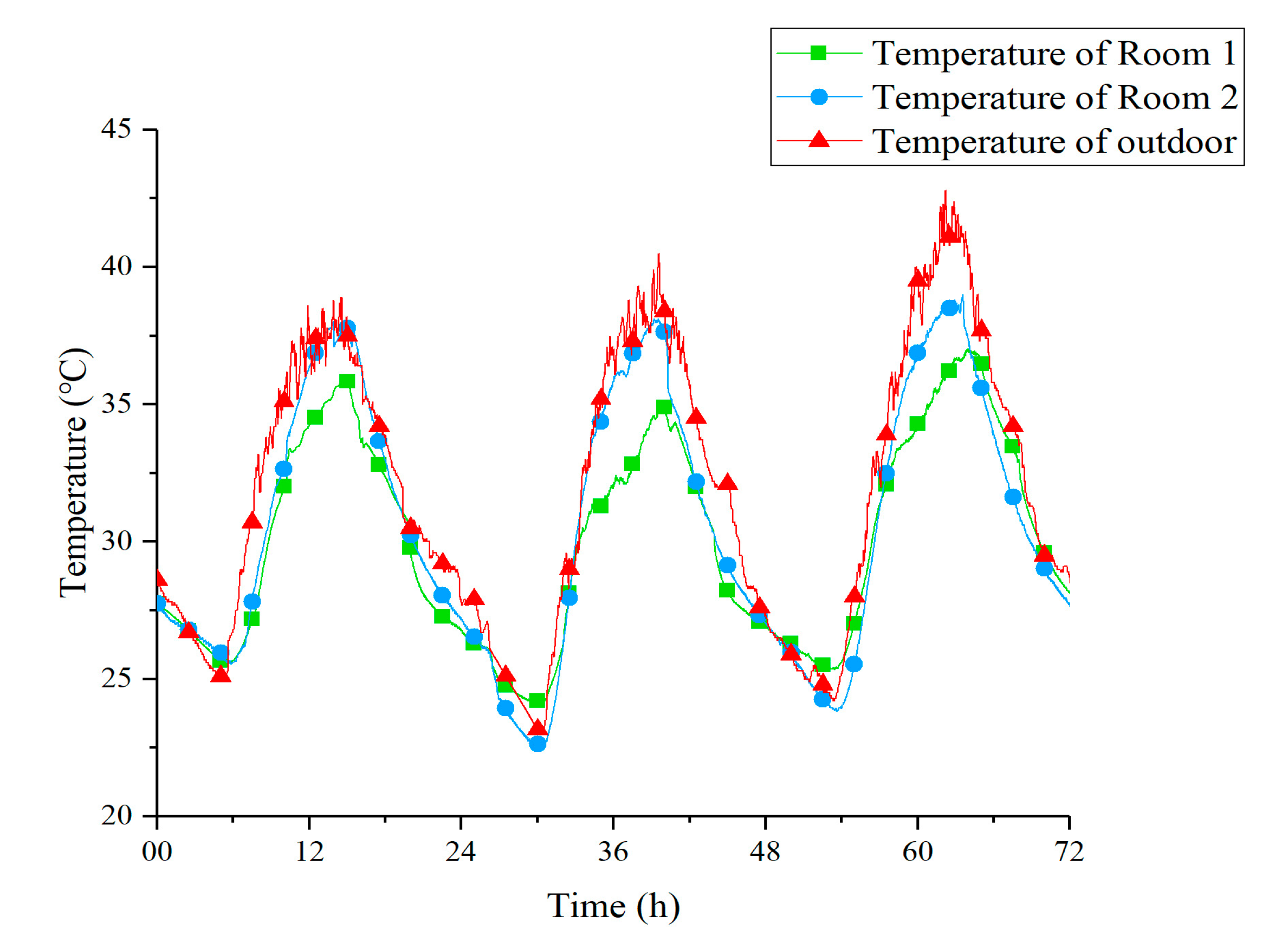
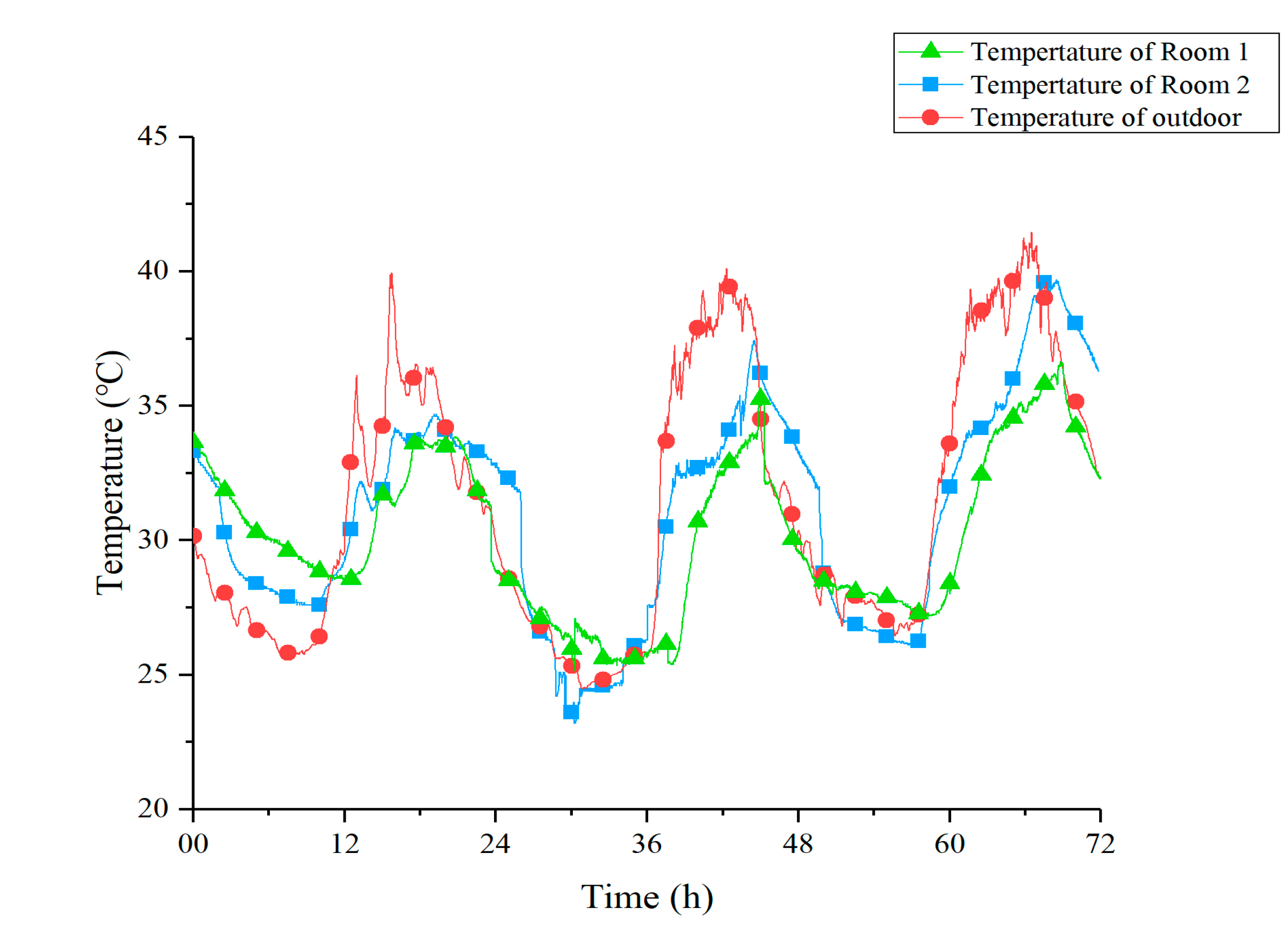


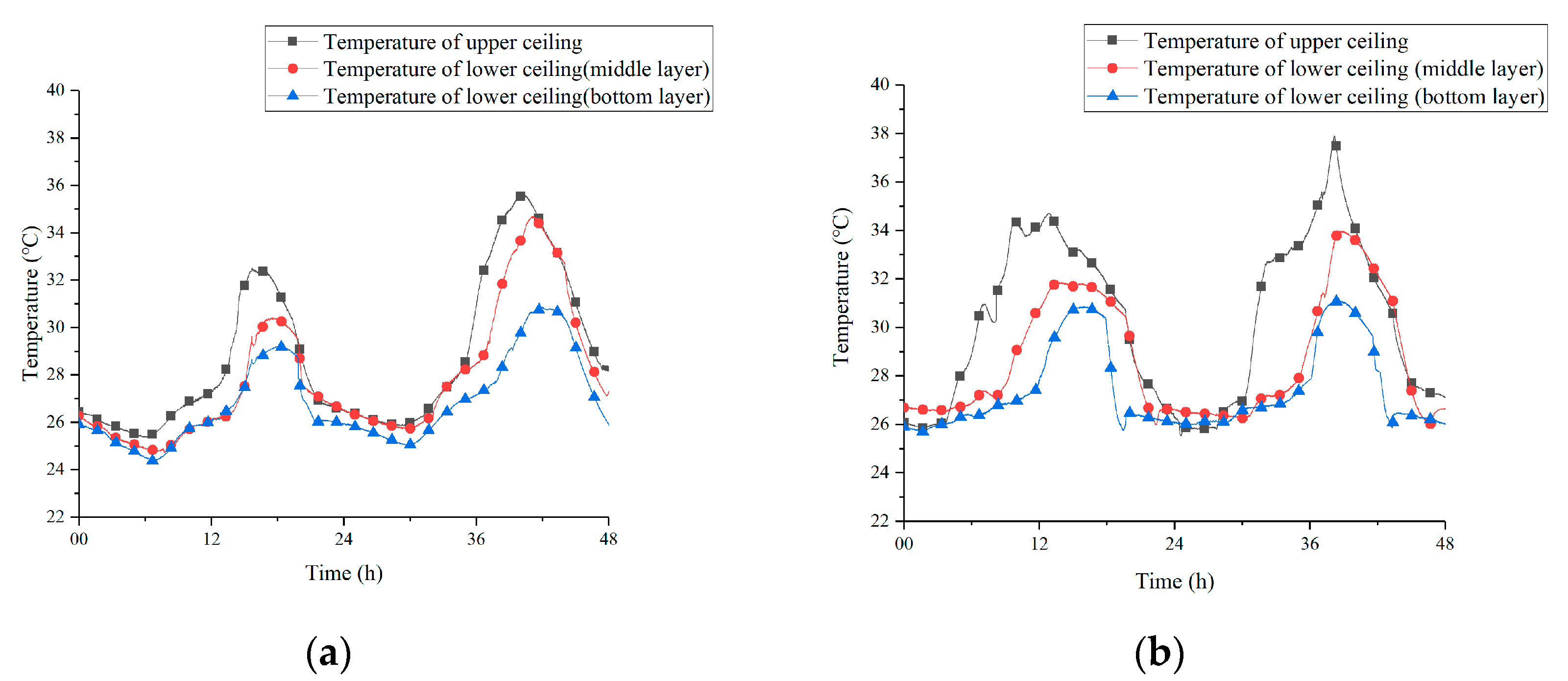
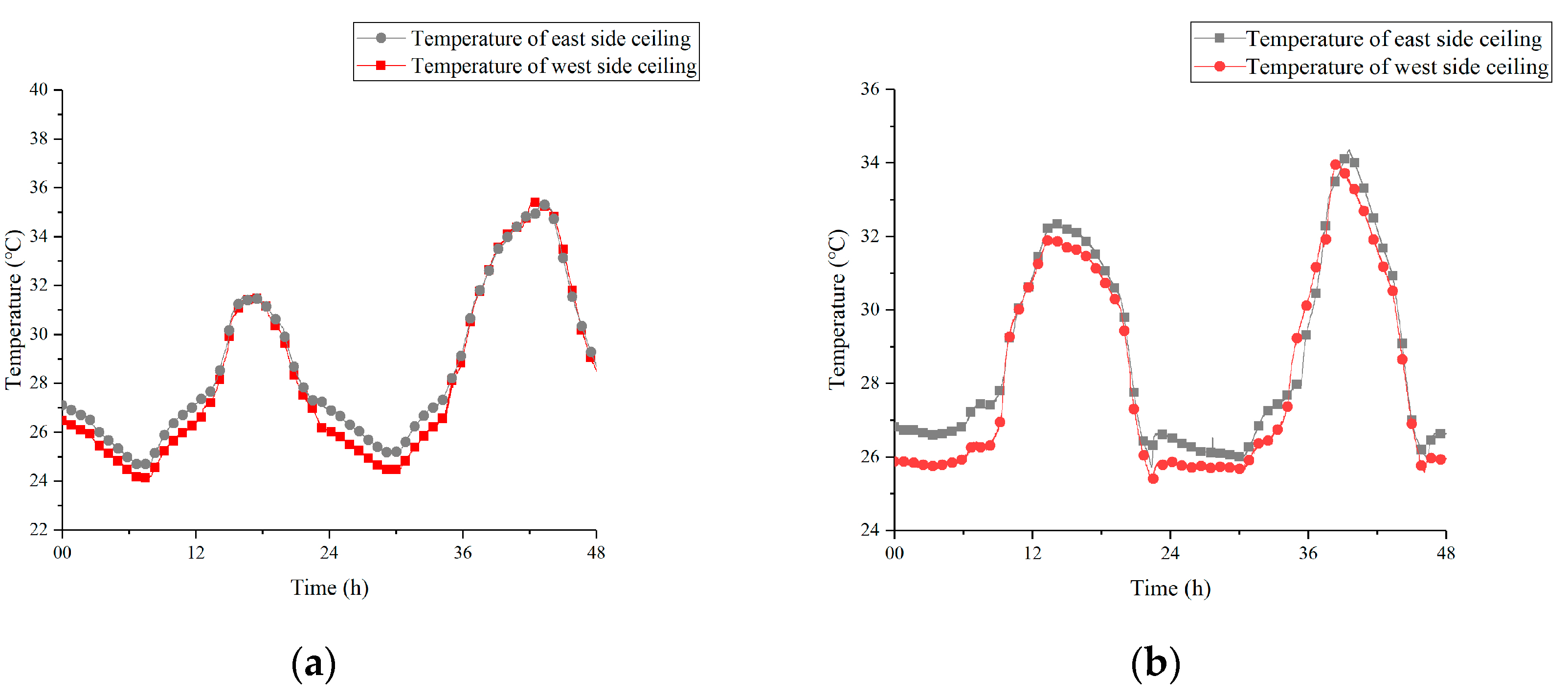
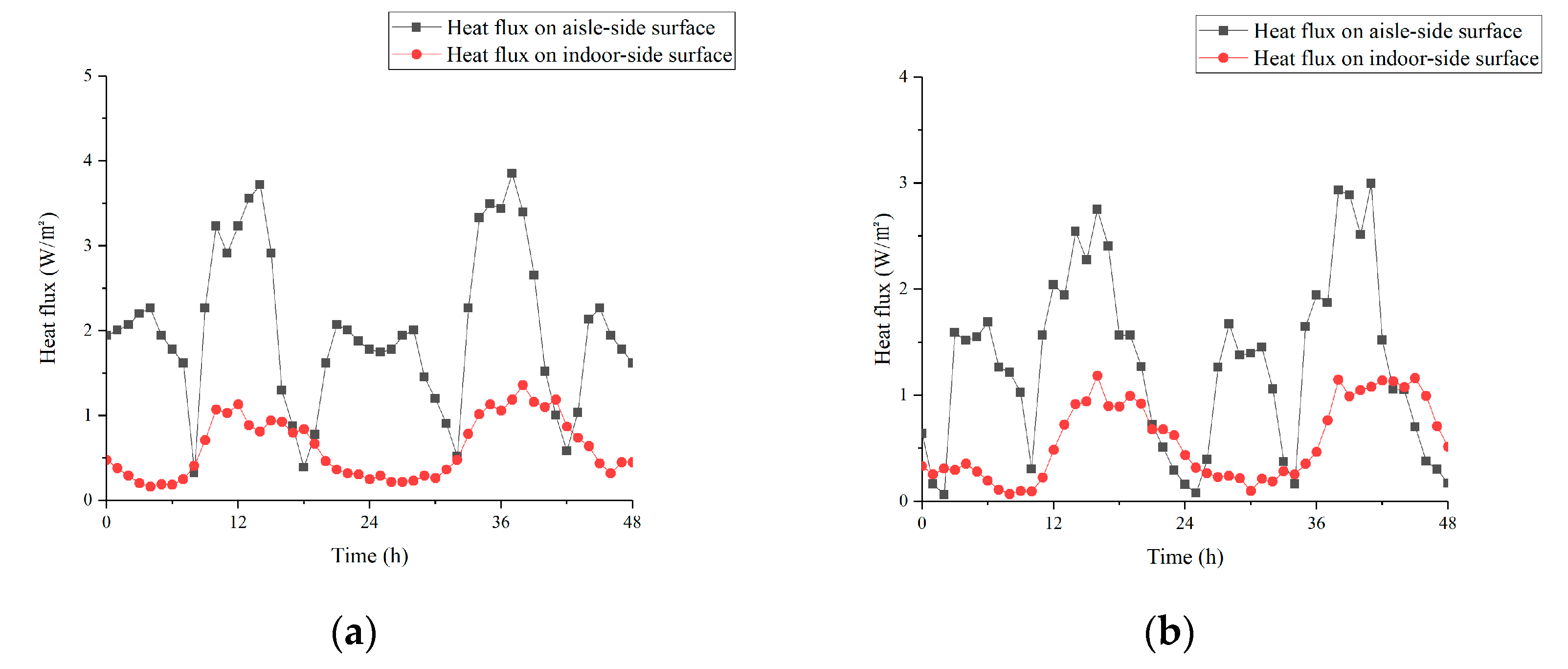
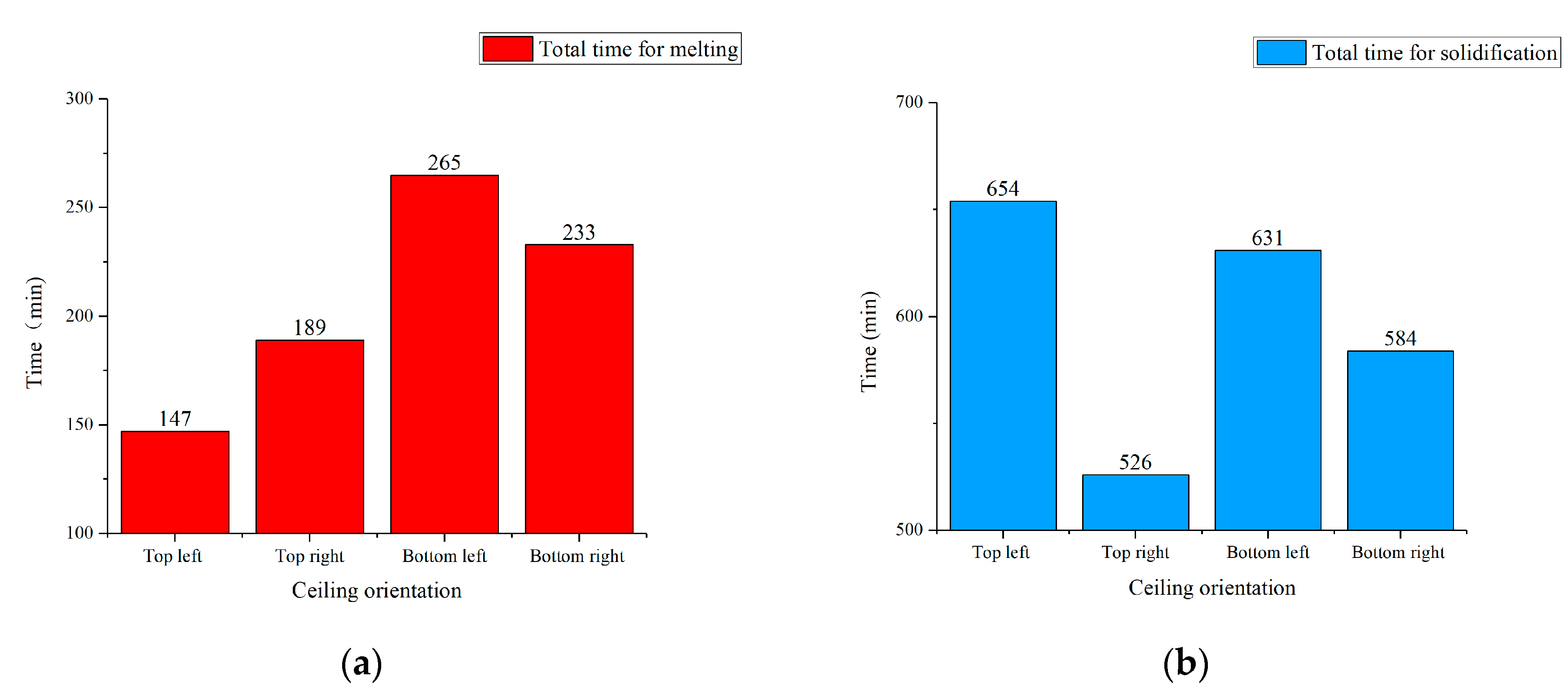
| Meteorological Parameters | Value |
|---|---|
| Land surface temperature (°C) | 13.5 |
| Land surface temperature amplitude (°C) | 15.4 |
| Outdoor dry-bulb temperature (°C) | 29.9 |
| Outdoor wind speed (m/s) | 2.4 |
| Outdoor air humidity (%) | 62.1 |
| Outdoor atmospheric pressure (kPa) | 101.7 |
| Parameter | Value |
|---|---|
| Diameter (mm) | 100 |
| Wind velocity (m/s) | 2.5 |
| Air flow (m3/h) | 70.7 |
| Tunnel length (m) | 12 |
| Parameter | Value |
|---|---|
| Thermal conductivity (W/(m·K)) | 0.16 |
| Specific heat at constant pressure (J/(g·K)) | 4.82 |
| Density (g/cm3) | 0.81 |
| Melting range (°C) | 27.95–31.02 |
| Melting peak temperature (°C) | 29.99 |
| Solidification range (°C) | 25.22–27.53 |
| Solidification peak temperature (°C) | 27.50 |
| Number of Cycles | Melting Point (°C) | Freezing Point (°C) | Latent Heat for Solidification Process (J/g) |
|---|---|---|---|
| 1th | 30.0 | 27.5 | 155.1 |
| 500th | 30.1 | 27.5 | 154.6 |
| 1000th | 30.2 | 27.4 | 154.4 |
| Name | Model | Accuracy |
|---|---|---|
| Thermocouple | T-type | ± 0.2 °C |
| Heat flow meter | RLJ-10050C | ≤5% |
| Data logger | 34972A | ≤0.0041% |
| Weather station | TINEL-QX5 | ± 2% |
| Strategy | Cooling Effect (°C) | Cooling Effect Decay between Two Adjacent Nights (°C) |
|---|---|---|
| Strategy 1 | 5.5 | 0.5 |
| Strategy 2 | 5.2 | 0.2 |
| Parameter | 13rd | 14th | 15th |
|---|---|---|---|
| Ts | 35.9 | 34.9 | 37.0 |
| Td | 38.8 | 38.1 | 39.0 |
| To | 38.9 | 40.5 | 42.7 |
| ∆T1 | 2.9 | 3.2 | 2.0 |
| ∆T2 | 3.0 | 5.6 | 5.7 |
| Parameter | 22nd | 23rd | 24th |
|---|---|---|---|
| Ts | 33.9 | 35.4 | 36.6 |
| Td | 34.7 | 37.5 | 39.9 |
| To | 40.0 | 40.1 | 41.5 |
| ∆T1 | 0.8 | 2.1 | 3.3 |
| ∆T2 | 6.1 | 4.7 | 4.9 |
| Strategy | |||||
|---|---|---|---|---|---|
| Strategy 1 | 35.9 | 38.6 | 40.7 | 2.7 | 4.8 |
| Strategy 2 | 35.3 | 37.4 | 40.5 | 2.1 | 5.2 |
© 2020 by the authors. Licensee MDPI, Basel, Switzerland. This article is an open access article distributed under the terms and conditions of the Creative Commons Attribution (CC BY) license (http://creativecommons.org/licenses/by/4.0/).
Share and Cite
Lu, S.; Liang, B.; Li, X.; Kong, X.; Jia, W.; Wang, L. Performance Analysis of PCM Ceiling Coupling with Earth-Air Heat Exchanger for Building Cooling. Materials 2020, 13, 2890. https://doi.org/10.3390/ma13132890
Lu S, Liang B, Li X, Kong X, Jia W, Wang L. Performance Analysis of PCM Ceiling Coupling with Earth-Air Heat Exchanger for Building Cooling. Materials. 2020; 13(13):2890. https://doi.org/10.3390/ma13132890
Chicago/Turabian StyleLu, Shilei, Bin Liang, Xinhua Li, Xiangfei Kong, Wei Jia, and Lu Wang. 2020. "Performance Analysis of PCM Ceiling Coupling with Earth-Air Heat Exchanger for Building Cooling" Materials 13, no. 13: 2890. https://doi.org/10.3390/ma13132890





